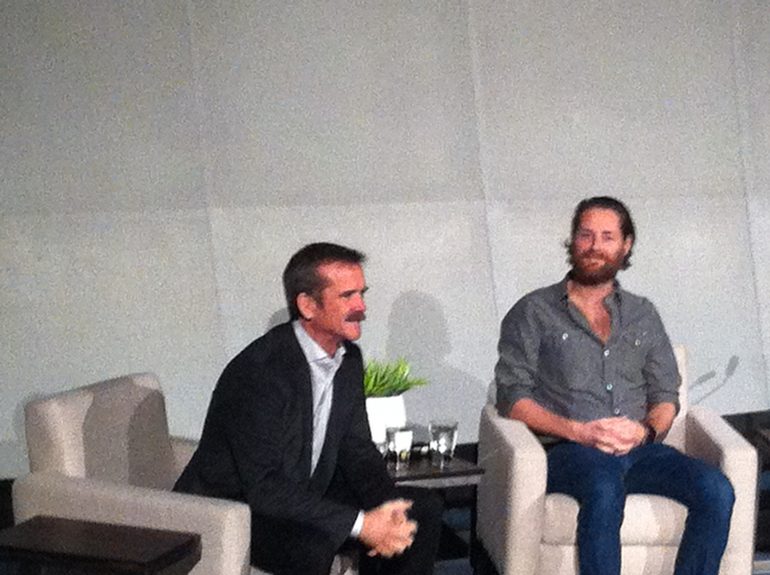They were introduced as the rock star astronaut and social media giant. Colonel Chris Hadfield and Hootsuite CEO Ryan Holmes kicked off the inaugural Innovators Speaker Series event for Science World at the TELUS World of Science last week.
Hadfield shouldn’t need much of an introduction, but it’s worth noting that he’s the pioneer of many “firsts” in Canadian space history. That includes: the first Canadian to use the Canadarm; the first Canadian to board a Russian spacecraft; the first Canadian to perform two spacewalks as a mission specialist on STS-100; and the first Canadian to command the International Space Station (ISS). He’s also currently promoting his book, An Astronaut’s Guide to Life on Earth.
Meanwhile, most of Canada’s technology community is familiar with Holmes’ efforts as the CEO of HootSuite. Beyond changing social media management for over seven million users across six continents, he’s also an authority on the social business revolution. Holmes further serves the community as an angel investor and advisor, mentoring startups in Canada and around the world.
While he wasn’t the first to tweet from space, he’s certainly prolific with his 140 character musings, so it seems only fitting for Hadfield and Holmes to have a conversation about science, space, the power of music and social media.
The evenings host, Riaz Meghji, had them each reflect on a conversation that proved to be of early importance in life. Holmes spoke about a Grade 12 teacher relating the story about 15th century workers throwing their sabots (wooden shoes) into the wooden gears of textile looms to break the cogs, fearing the automated machines would render the human workers obsolete.
Sharing the origin of the word saboteur, Holmes said that “change is inevitable, so throughout my career I’ve thought about the resistance to the change of technology, and tried to adopt it, embrace it, and be on the frontside of the wave. I think that has really stuck with me.”
It shouldn’t come as a surprise when Hadfield revealed that “two guys named Buzz & Neil” were his inspirations.
He spoke in revered terms about the first lunar landing. Above all, he said was “their conversation and making the decision to find a new landing place, in spite of limited fuel. It was a lifetime of building the knowledge, awareness, and professionalism that allowed them to find safe place to touch down. They only had 16 seconds of fuel left.”
With Buzz and Neil averting disaster and announcing “the eagle has landed”, Hadfield’s deciding against extraordinarily long odds to become an astronaut was set. His advice for what it takes to become an astronaut is pretty good lifestyle advice in general. He says “take care of your body. Eat smart and exercise a little; get an advanced education; practice decision making. The more decisions you choose to make the better you’ll get over time.”
Holmes asked if space tourism is realistic? As Hadfield pointed out “private citizens have paid up to now some $30 million to go, including the founder of Cirque du Soleil who bought a ride with Russians. He spent six weeks training in Russia to fly aboard Soyuz. As well, you’ll soon be able to spend $250,000 and fly Virgin Galactic to get the sense of weightlessness.” Hadfield likened the future of spaceflight being an everyman experience to that of the history of buying an airline ticket. One day it will be commonplace.
Hadfield asked Holmes about how business plays an important role in the community, noting that it’s not just about being a revenue generating endeavour. Holmes shared his excitement for launching a new foundation, The Next Big Thing, which “is about the discovery of the next generation of entrepreneurs. Ten 17-18 years olds (who are probably asking themselves what’s next?) will be given the opportunity to discover anything from a new twist on the lemonade stand to a new software idea. We’ll get them set up at Hootsuite HQ, and connected with a bursary to lessen the risk, and with mentors who will help propel their ideas forward.”
Crediting his nephew for the question, Holmes line of scientific inquiry moved to a little body function junction when asking “what happens when you fart in space?“ Hadfield had some fun, and patiently offered that “gravity won’t let you burp in space.” You can reverse engineer the answer to gas, as he further suggested that “it’s non-propulsive, which is likely result of poor nozzle design.”
With almost one million Twitter followers (@Cmdr_Hadfield) (and a YouTube success with his remake of Space Oddity, garnering over 19 million views), Hadfield doesn’t just talk a good social game. He thinks the popularity of the video is because it “crosses over between the fantasy and the reality of spaceflight, and gets people thinking of what’s going on in the Space Station.”
At one point it seemed as if Hadfield was actually channeling Holmes, when talking about social media having to be a social experience. He suggested that you need to really care about what you’re communicating with 140 characters. It’s an opportunity to engage in meaningful thought and the exchange of ideas..
However, appreciating the sight of our planet from space Hadfield leaves us all with the most important thought to ruminate on, simply saying, “we’re in this together. “




